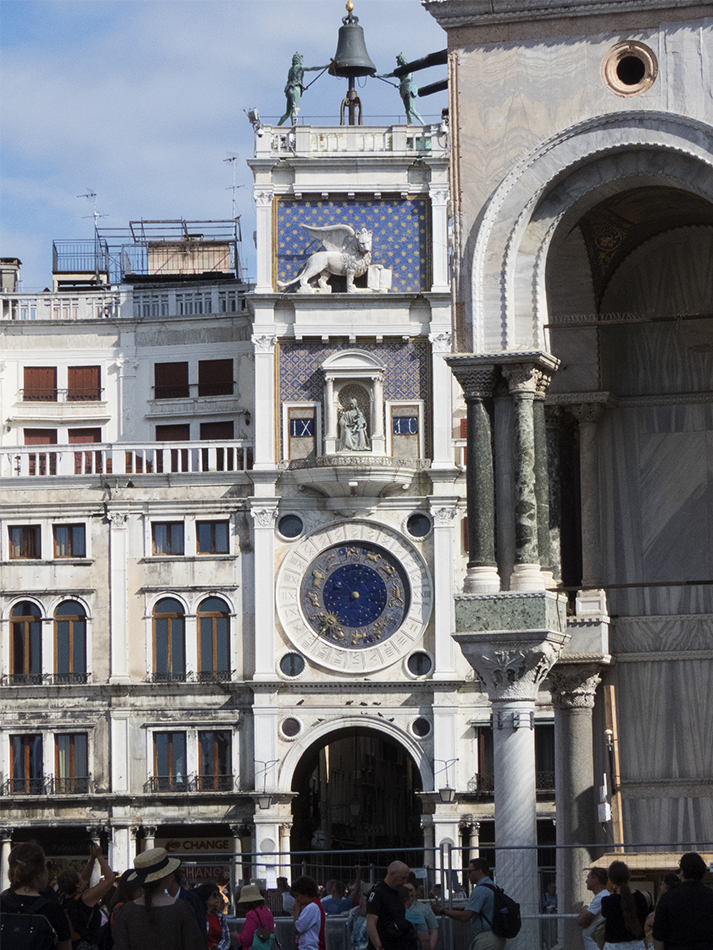
Although time and its measurement is a fundamental component of human life, a special type of clock which takes matters to the next level is the so-called
astronomical clock and whose purpose is not to measure time per se but to convey astronomical information and, in particular, the relative position of the
Sun and Moon as well as the zodiacal constellations and, in some cases, the position of the planets all as a function of time.
The oldest such effort to effectively emulate the overhead celestial sphere (ie a mini-planetarium) is the
Antikythera Mechanism which was discovered in 1901 totally by
accident by sponge divers off the coast of the Greek island of Antikythera. It has been dated to approximately 80 BC and it is believed to be the work of
Poseidonius of Rhodes. The Antikythera Mechanism is currently on display
at the National Archaeological Museum in Athens, Greece.
Note: With a population of only 55,000 people, Venice is host to approximately 25 to 30 million tourists each year owing to the
fact it is generally regarded as one of the most beautiful and romantic cities in the world thanks to stunning architecture, countless water canals and bridges,
lively festivals as well as being the birthplace of rennaisance art and music. To this end, Venice is often described as the "City of Canals", the "City of
Water", the "City of Masks" and the "City of Bridges" amongst others. Its uniqueness was recognized by UNESCO when the city was incorporated into the
catalog of World Heritage Sites in 1987.
The primary square in Venice, Piazza di San Marco (St Mark's Square), is one of the primary attractions in Venice thanks to the Basilica di San Marco, named after
the patron saint of the city, and which forms the eastern facade of the square. To the immediate north of the basilica and the square's northeastern quadrant,
one will encounter the clock tower ("Torre dell'Orologio") whose construction during 1496-1497 involved the father and son team of Gian Paolo and Gian Carlo
Rainieri. Having undergone many restorations during the past 500 years including the latest during 1996-1999, tradition similar to what was practised with
other clock towers in Europe saw the presence of a permanent timekeeper (horologist) who lived in the tower (along with his family) so as to service and
maintain the clock. This practise would continue for literally 500 years, often involving generations of the same family, and until 1998 when it was
finally abandoned.
The design of the clock is very much similar to other clocks of the time with various concentric rings representing the hour of day, the month with the
zodiacal constellation the Sun was passing through, phases of the moon etc. More specifically and as can be seen in the photo below, the outer ring is made
from marble and has the Roman numerals I through XXIV inscribed and which represent the hour of day starting with "I" between the 3 and 4 o'clock positions
of a modern-day clock. The next ring which follows involves the zodiacal constellations with their appropriate symbols in gold colour set against a dark
background where a mobile pendant with a golden Sun straddles the outermost two rings indicating the current hour and position of the Sun amongst the zodiacal
constellations. A much smaller ring follows for the date of the month with demarcations in five-day segments (ie. "5", "10", "15", "20", "25" and "30").
The innermost disk follows and which contains the Earth at its center due to the prevailing Aristotelian/Ptolemaic geocentric view of the Solar System at
the time along with a rotating ring for the Moon undergoing suitable changes in its phase as well as depicting its travels along the zodiac. This ring is
set against a blue background reflecting the sky and includes various stars interspersed throughout. The original version
of the clock also included the five planets with their own rings so as to be compatible with the Ptolemaic model but were eventually removed with today's
version being in its most simplistic form. In fact, it is believed that Galileo was instrumental in having the five planetary rings removed following his
invitation to visit Venice and see the newly-built clock.
The clock tower's internals are open to the public and 50-minute guided tours requiring pre-booking are available with groups limited to a maximum of five
members due to the tight quarters inside the clock tower.
Note: For a view of the astronomical clock using greater focal length, please click
here and
here.
Note: For additional results involving astronomical clocks from around the world, please click
here.
|
Body: Sun Mass: 332,900 x Earth Mass Eq Diameter: 109.1 x Earth Distance: 149 million km RA / Dec: 23h 41m 41s / +89° 19' 51" Diameter: 32.16' Magnitude: -26.8 |
 |
Date: June 12, 2023 Location: Piazza di San Marco, Venice, Italy Equipment: Canon PowerShot SX60 HS @ 23.38 mm / f8.0 Exposure: 1 x 1/1000 sec ISO 400 RAW Image Format 4768x3516 Image Size Continuous Servo Mode Manual Mode Software: Photoshop CS6 Processing: Brightness/Contrast Resampling JPG Compression |